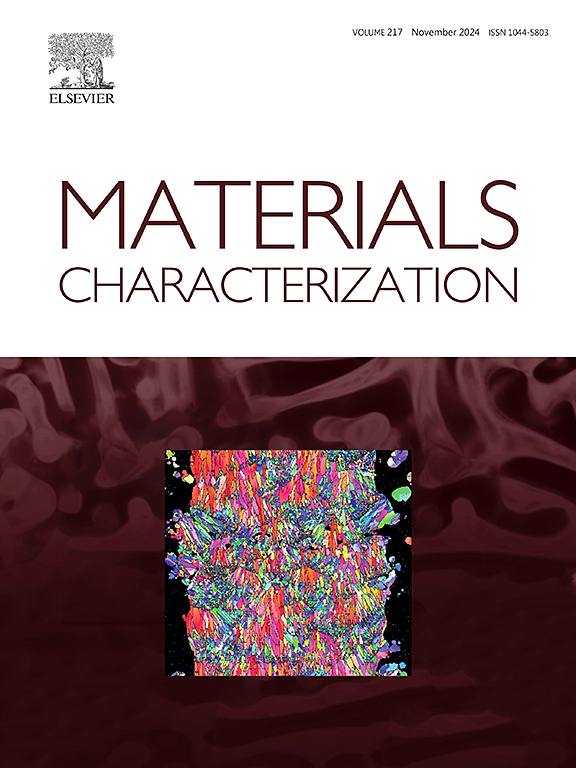利用(100)、(110)和(123)取向单晶揭示氧化膜缺陷控制奥氏体不锈钢在超临界二氧化碳中各向异性腐蚀速率的机理
IF 4.8
2区 材料科学
Q1 MATERIALS SCIENCE, CHARACTERIZATION & TESTING
引用次数: 0
摘要
采用奥氏体不锈钢单晶((100)、(110)和(123)取向)在超临界二氧化碳环境中,通过SEM、XRD、TEM表征和DFT计算,研究了腐蚀速率与取向的关系。结果表明:各样品表面均形成了典型的双层结构氧化层,(110)和(123)取向的生长速率较(100)取向显著提高,分别达到111.7%和137.4%;DFT分析表明(110)和(123)表面的表面能分别比(100)表面高4.5%和9.6%,建立了表面能与氧化物生长动力学之间的正相关关系。表面能与Fe向外扩散和氧化速率呈正相关,并决定了外层磁铁矿层的厚度。在双相内层中,高表面能试样尖晶石相中Fe和O的反扩散增强,促进了缺陷浓度的升高。这种现象是由加速铁从基体向外扩散协同驱动的,从而为氧向内扩散提供了额外的途径。这使得氧化前沿不断地供给氧气,从而形成较厚的具有超细双相结构的内氧化层。本文章由计算机程序翻译,如有差异,请以英文原文为准。

Revealing the mechanism of oxide film defects governing the anisotropic corrosion rate of austenitic stainless steel in supercritical carbon dioxide using (100), (110), and (123) oriented single crystals
The dependence of corrosion rate on crystal orientation was studied using austenitic stainless steel single crystals ((100), (110) and (123)-oriented) in supercritical carbon dioxide, supported by SEM, XRD, TEM characterization and DFT calculations. The results show that a typical dual-layer structured oxide scale is formed on each sample, with the (110) and (123) orientations exhibiting significantly enhanced growth rates of 111.7 % and 137.4 %, respectively, relative to the (100) orientation. DFT analysis reveals that the (110) and (123) surfaces possess 4.5 % and 9.6 % higher surface energies, respectively, than the (100) surface, establishing a positive correlation between surface energy and oxide growth kinetics. The surface energy is positively correlated with the outward diffusion and oxidation rate of Fe, and determines the thickness of the outer magnetite layer. In the biphasic inner layer, the enhanced counter-diffusion of Fe and O in the spinel phase of high-surface-energy specimens facilitates the formation of elevated defect concentrations. This phenomenon is synergistically driven by accelerated outward Fe diffusion from the substrate matrix, thus providing additional pathways for inward oxygen diffusion. This continuously supplies oxygen to the oxidation front, thereby a thicker inner oxide layer with ultrafine duplex structure is formed.
求助全文
通过发布文献求助,成功后即可免费获取论文全文。
去求助
来源期刊

Materials Characterization
工程技术-材料科学:表征与测试
CiteScore
7.60
自引率
8.50%
发文量
746
审稿时长
36 days
期刊介绍:
Materials Characterization features original articles and state-of-the-art reviews on theoretical and practical aspects of the structure and behaviour of materials.
The Journal focuses on all characterization techniques, including all forms of microscopy (light, electron, acoustic, etc.,) and analysis (especially microanalysis and surface analytical techniques). Developments in both this wide range of techniques and their application to the quantification of the microstructure of materials are essential facets of the Journal.
The Journal provides the Materials Scientist/Engineer with up-to-date information on many types of materials with an underlying theme of explaining the behavior of materials using novel approaches. Materials covered by the journal include:
Metals & Alloys
Ceramics
Nanomaterials
Biomedical materials
Optical materials
Composites
Natural Materials.
 求助内容:
求助内容: 应助结果提醒方式:
应助结果提醒方式:


